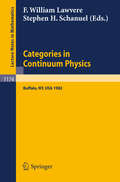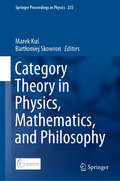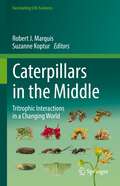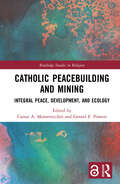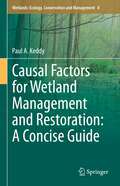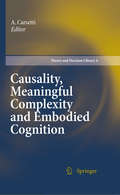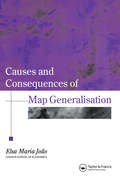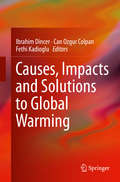- Table View
- List View
Categorical Donaldson-Thomas Theory for Local Surfaces (Lecture Notes in Mathematics #2350)
by Yukinobu TodaThis book provides an introduction to categorical Donaldson-Thomas (DT) theory, a rapidly developing field which has close links to enumerative geometry, birational geometry, geometric representation theory and classical moduli problems in algebraic geometry. The focus is on local surfaces, i.e. the total spaces of canonical line bundles on algebraic surfaces, which form an interesting class of Calabi-Yau 3-folds. Using Koszul duality equivalences and singular support theory, dg-categories are constructed which categorify Donaldson-Thomas invariants on local surfaces. The DT invariants virtually count stable coherent sheaves on Calabi-Yau 3-folds, and play an important role in modern enumerative geometry, representation theory and mathematical physics. Requiring a basic knowledge of algebraic geometry and homological algebra, this monograph is primarily addressed to researchers working in enumerative geometry, especially Donaldson-Thomas theory, derived categories of coherent sheaves, and related areas.
Categories, Bundles and Spacetime Topology (Mathematics and Its Applications #45)
by C.T. DodsonApproach your problems from the right end It isn't that they can't see the solution. It is and begin with the answers. Then one day, that they can't see the problem. perhaps you will find the final question. G. K. Chesterton. The Scandal of Father 'The Hermit Gad in Crane Feathers' in R. Brown'The point of a Pin'. van Gulik's TheChinese Maze Murders. Growing specialization and diversification have brought a host of monographs and textbooks on increasingly specialized topics. However, the "tree" of knowledge of mathematics and related fields does not grow only by putting forth new branches. It also happens, quite often in fact, that branches which were thought to be completely disparate are suddenly seen to be related. Further, the kind and level of sophistication of mathematics applied in various sciences has changed drastically in recent years: measure theory is used (non-trivially) in regional and theoretical economics; algebraic geometry interacts with physics; the Minkowsky lemma, coding theory and the structure of water meet one another in packing and covering theory; quantum fields, crystal defects and mathematical programming profit from homotopy theory; Lie algebras are relevant to filtering; and prediction and electrical engineering can use Stein spaces. And in addition to this there are such new emerging SUbdisciplines as "experimental mathematics", "CFD", "completely integrable systems", "chaos, synergetics and large-scale order", which are almost impossible to fit into the existing classification schemes. They draw upon widely different sections of mathematics.
Categories in Continuum Physics: Lectures Given at a Workshop Held at SUNY, Buffalo 1982 (Lecture Notes in Mathematics #1174)
by F. William Lawvere Stephen H. SchanuelCategory 5: The Story of Camille, Lessons Unlearned from America's Most Violent Hurricane
by Judith A. Howard Ernest ZebrowskiThe epic story of the real victims of a perfect storm— overwhelmingly the poor— left behind in the aftermath of a deadly hurricane “ A riveting new book.” — Tallahassee Democrat “ Not simply an historical account of a storm thirty-seven years ago but a living, breathing entity brimming with the modern-day reality that, yes, it can happen again.” — American Meteorological Society Bulletin "Fascinating, easy-to-read, yet informative.” — Richmond Times-Dispatch “ Almost like sitting in front of the television watching the events unfold. A page-turner from the very first page.” — Ruston Morning Paper “ There is much we can all learn from this relevant and highly engaging chronicle.” — Biloxi Sun Herald “ A must-read for anyone who wants to take an emotional stroll through the rubble of these Gulf Coast fishing communities and learn what happened.” — Apalachicola Times “ Should be required reading for anyone living in the path of these terrible storms.” — Moondance.org As the unsettled social and political weather of summer 1969 played itself out amid the heat of antiwar marches and the battle for civil rights, three regions of the rural South were devastated by the horrifying force of Category 5 Hurricane Camille. Camille’ s nearly 200 mile per hour winds and 28-foot storm surge swept away thousands of homes and businesses along the Gulf Coast of Louisiana and Mississippi. Twenty-four oceangoing ships sank or were beached; six offshore drilling platforms collapsed; 198 people drowned. Two days later, Camille dropped 108 billion tons of moisture drawn from the Gulf onto the rural communities of Nelson County, Virginia— nearly three feet of rain in 24 hours. Mountainsides were washed away; quiet brooks became raging torrents; homes and whole communities were simply washed off the face of the earth. In this gripping account, Ernest Zebrowski and Judith Howard tell the heroic story of America’ s forgotten rural underclass coping with immense adversity and inconceivable tragedy. Category 5shows, through the riveting stories of Camille’ s victims and survivors, the disproportionate impact of natural disasters on the nation’ s poorest communities. It is, ultimately, a story of the lessons learned— and, in some cases, tragically unlearned— from that storm: hard lessons that were driven home once again in the awful wake of Hurricane Katrina. Ernest Zebrowski is founder of the doctoral program in science and math education at Southern University, a historically black university in Baton Rouge, Louisiana, and Professor of Physics at Pennsylvania State University’ s Pennsylvania College of Technology. His previous books include Perils of a Restless Planet: Scientific Perspectives on Natural Disasters. Judith Howard earned her Ph.D. in clinical social work from UCLA, and writes a regular political column for the Ruston, Louisiana, Morning Paper.
Category Theory in Physics, Mathematics, and Philosophy (Springer Proceedings in Physics #235)
by Marek Kuś Bartłomiej SkowronThe contributions gathered here demonstrate how categorical ontology can provide a basis for linking three important basic sciences: mathematics, physics, and philosophy. Category theory is a new formal ontology that shifts the main focus from objects to processes.The book approaches formal ontology in the original sense put forward by the philosopher Edmund Husserl, namely as a science that deals with entities that can be exemplified in all spheres and domains of reality. It is a dynamic, processual, and non-substantial ontology in which all entities can be treated as transformations, and in which objects are merely the sources and aims of these transformations.Thus, in a rather surprising way, when employed as a formal ontology, category theory can unite seemingly disparate disciplines in contemporary science and the humanities, such as physics, mathematics and philosophy, but also computer and complex systems science.
Caterpillars in the Middle: Tritrophic Interactions in a Changing World (Fascinating Life Sciences)
by Robert J. Marquis Suzanne KopturCaterpillars are excellent model organisms for understanding how multiple selective forces shape the ecology and evolution of insects, and organisms in general. Recent research using the tools of modern molecular biology, genetics, metabolomics, microbial ecology, experiments conducted at a global level, network analysis, and statistical analyses of global data sets, combined with basic natural history, are yielding exciting new insights into caterpillar adaptations and ecology. The best way to view these research advances is within a framework of tri-trophic interactions. This is a timely topic for research given the central role of caterpillars and plants in the ecology and trophic structure of terrestrial communities. This book is unique in that it contains chapters from a team of experts on a diversity of key topics within caterpillar-plant interactions. This volume brings together contributions by researchers from around the globe, working in both tropical and temperate habitats, and in human-managed and more natural habitats. It is a significant contribution to our understanding of insect biology, and the role that insects, as represented by caterpillars, play in a world increasingly dominated by humans and one in which threats to insect biodiversity are mounting.Chapter 11 is available open access under a Creative Commons Attribution 4.0 International License via link.springer.com.
Cathodoluminescence and its Application in the Planetary Sciences
by Arnold GucsikCathodoluminescence microscopy/spectroscopy is a powerful technique providing detailed information on the shock metamorphism of target rocks, biosignatures of meteorites and mineralogy of the pre-solar grains. Moreover, it can be used as an in-situ method to classify the solid-atmospheric-liquid interactions on the surface of Mars.
Cathodoluminescence in Geosciences
by D. Ohnenstetter M. Pagel V. Barbin P. BlancAn up-to-date overview of cathodoluminescence microscopy and spectroscopy in the field of geosciences, including new important data on cathodoluminescence spectroscopy, physical parameters and systematic spectral analysis of doped minerals. Each chapter, written by a well-known specialist, covers classic and new fields of application such as carbonate diagenesis, silicates, brittle deformation in sandstones, gemstone recognition, biomineralization, economic geology or geochronology. Useful to all scientists, graduates and professional engineers throughout the geosciences community.
Catholic Peacebuilding and Mining: Integral Peace, Development, and Ecology (Routledge Studies in Religion)
by Caesar A. MontevecchioThis book explores the role of Catholic peacebuilding in addressing the global mining industry. Mining is intimately linked to issues of conflict, human rights, sustainable development, governance, and environmental justice. As an institution of significant scope and scale with a large network of actors at all levels and substantial theoretical and ethical resources, the Catholic Church is well positioned to acknowledge the essential role of mining, while challenging unethical and harmful practices, and promoting integral peace, development, and ecology. Drawing together theology, ethics, and praxis, the volume reflects the diversity of Catholic action on mining and the importance of an integrated approach. It includes contributions by an international and interdisciplinary range of scholars and practitioners. They examine Catholic action on mining in El Salvador, Peru, Colombia, the Democratic Republic of the Congo, and the Philippines. They also address general issues of corporate social responsibility, human rights, development, ecology, and peacebuilding. The book will be of interest to scholars of theology, social ethics, and Catholic studies as well as those specializing in development, ecology, human rights, and peace studies.
Catholic Peacebuilding and Mining: Integral Peace, Development, and Ecology (Routledge Studies in Religion)
by Caesar A. Montevecchio Gerard F. PowersThis book explores the role of Catholic peacebuilding in addressing the global mining industry. Mining is intimately linked to issues of conflict, human rights, sustainable development, governance, and environmental justice. As an institution of significant scope and scale with a large network of actors at all levels and substantial theoretical and ethical resources, the Catholic Church is well positioned to acknowledge the essential role of mining, while challenging unethical and harmful practices, and promoting integral peace, development, and ecology. Drawing together theology, ethics, and praxis, the volume reflects the diversity of Catholic action on mining and the importance of an integrated approach. It includes contributions by an international and interdisciplinary range of scholars and practitioners. They examine Catholic action on mining in El Salvador, Peru, Colombia, the Democratic Republic of the Congo, and the Philippines. They also address general issues of corporate social responsibility, human rights, development, ecology, and peacebuilding. The book will be of interest to scholars of theology, social ethics, and Catholic studies as well as those specializing in development, ecology, human rights, and peace studies.
Cattle Colonialism: An Environmental History of the Conquest of California and Hawai'i (Flows, Migrations, and Exchanges)
by John Ryan FischerIn the nineteenth century, the colonial territories of California and Hawai'i underwent important cultural, economic, and ecological transformations influenced by an unlikely factor: cows. The creation of native cattle cultures, represented by the Indian vaquero and the Hawaiian paniolo, demonstrates that California Indians and native Hawaiians adapted in ways that allowed them to harvest the opportunities for wealth that these unfamiliar biological resources presented. But the imposition of new property laws limited these indigenous responses, and Pacific cattle frontiers ultimately became the driving force behind Euro-American political and commercial domination, under which native residents lost land and sovereignty and faced demographic collapse.Environmental historians have too often overlooked California and Hawai'i, despite the roles the regions played in the colonial ranching frontiers of the Pacific World. In Cattle Colonialism, John Ryan Fischer significantly enlarges the scope of the American West by examining the trans-Pacific transformations these animals wrought on local landscapes and native economies.
Caught by Disorder: Bound States in Random Media (Progress in Mathematical Physics #20)
by Peter StollmannDisorder is one of the predominant topics in science today. The present text is devoted to the mathematical studyofsome particular cases ofdisordered systems. It deals with waves in disordered media. To understand the significance of the influence of disorder, let us start by describing the propagation of waves in a sufficiently ordered or regular environment. That they do in fact propagate is a basic experience that is verified by our senses; we hear sound (acoustic waves) see (electromagnetic waves) and use the fact that electromagnetic waves travel long distances in many aspects ofour daily lives. The discovery that disorder can suppress the transport properties of a medium is oneof the fundamental findings of physics. In its most prominent practical application, the semiconductor, it has revolutionized the technical progress in the past century. A lot of what we see in the world today depends on that relatively young device. The basic phenomenon of wave propagation in disordered media is called a metal-insulator transition: a disordered medium can exhibit good transport prop erties for waves ofrelatively high energy (like a metal) and suppress the propaga tion of waves of low energy (like an insulator). Here we are actually talking about quantum mechanical wave functions that are used to describe electronic transport properties. To give an initial idea of why such a phenomenon could occur, we have to recall that in physical theories waves are represented by solutions to certain partial differential equations. These equations link time derivatives to spatial derivatives.
Causal Factors for Wetland Management and Restoration: A Concise Guide (Wetlands: Ecology, Conservation and Management #8)
by Paul A. KeddyThis book presents 12 effective methods to manage wetlands for conservation. It offers a tool box of causal factors that can be used to protect and restore wetlands to enhance biological diversity and other functions. Each causal factor is introduced, briefly explained, and then illuminated with selected examples from around the world.The book provides a prioritized shopping list of methods for protecting and restoring wetlands. The three first and most important causal factors are flooding, fertility, and natural disturbance. Then nine other causal factors are introduced, including herbivory, sedimentation, roads, invasive species, and coarse woody debris. Each causal factor is carefully linked to the scientific literature and explained using the author’s own experience. The same list of 12 causal factors applies around the world—whether you are managing a temperate zone floodplain, a tropical peatland, a freshwater marsh, or a coastal mangrove swamp. Instead of hiring an expensive team of consultants, or pouring through hundreds of scientific papers, here is one concise guide to methods that can be immediately applied to benefit any wetland.Professor Paul Keddy has spent more than 50 years studying wetlands, and writing and lecturing about the environmental factors that control them. He has published more than 150 scholarly papers, and won multiple scientific prizes. His book Wetland Ecology is widely used to teach the principles of wetland science. Causal Factors for Wetland Management: A Concise Guide has a much simpler message: how to protect and enhance wetlands. In this concise guide, he has condensed a lifetime of experience into just 12 principles. The book is aimed at all people who protect or restore wetlands: park managers, wildlife biologists, landscape architects, engineers, environmental consultants, environmental agencies, conservation authorities, and NGOs—as well as landowners and concerned citizens. Causal Factors for Wetland Management: A Concise Guide is essential reading for anyone who cares for wetlands and wild places.
Causality and Locality in Modern Physics: Proceedings of a Symposium in honour of Jean-Pierre Vigier (Fundamental Theories of Physics #97)
by G. Hunter Stanley Jeffers J. P. VigierThe Symposium entitled: Causality and Locality in Modern Physics and As tronomy: Open Questions and Possible Solutions was held at York University, Toronto, during the last week of August 1997. It was a sequel to a similar sym posium entitled: The Present Status of the Quantum Theory of Light held at the same venue in August 1995. These symposia came about as a result of discussions between Professor Stanley Jeffers and colleagues on the International Organizing Committee. Professor Jeffers was the executive local organizer of the symposia. The 1997 symposium attracted over 120 participants representing 26 different countries and academic institutions. The broad theme of both symposia was the enigma of modern physics: the non-local, and possibly superluminal interactions implied by quantum mechanics, the structure of fundamental particles including the photon, the reconciliation of quantum mechanics with the theory of relativity, and the nature of gravity and inertia. Jean-Pierre Vigier was the guest of honour at both symposia. He was a lively contributor to the discussions of the presentations. The presentations were made as 30-minute lectures, or during an evening poster session. Some participants did not submit a written account of their presentation at the symposium, and not all of the articles submitted for the Proceedings could be included because of the publisher's page limit. The titles and authors of the papers that had to be excluded are listed in an appendix.
Causality, Meaningful Complexity and Embodied Cognition (Theory and Decision Library A: #46)
by A. CarsettiArturo Carsetti According to molecular Biology, true invariance (life) can exist only within the framework of ongoing autonomous morphogenesis and vice versa. With respect to this secret dialectics, life and cognition appear as indissolubly interlinked. In this sense, for instance, the inner articulation of conceptual spaces appears to be linked to an inner functional development based on a continuous activity of selection and “anchorage” realised on semantic grounds. It is the work of “invention” and g- eration (in invariance), linked with the “rooting” of meaning, which determines the evolution, the leaps and punctuated equilibria, the conditions related to the unfo- ing of new modalities of invariance, an invariance which is never simple repetition and which springs on each occasion through deep-level processes of renewal and recovery. The selection perpetrated by meaning reveals its autonomy aboveall in its underpinning, in an objective way, the ongoing choice of these new modalities. As such it is not, then, concerned only with the game of “possibles”, offering itself as a simple channel for pure chance, but with providing a channel for the articulation of the “ le” in the humus of a semantic (and embodied) net in order to prepare the necessary conditionsfor a continuousrenewal and recoveryof original creativity. In effect, it is this autonomy in inventing new possible modules of incompressibility whichdeterminestheactualemergenceofnew(andtrue)creativity,whichalsotakes place through the “narration” of the effected construction.
Causes And Consequences Of Map Generalization
by Elsa JoaoThis text describes late-1990s understanding of map generalisation in the context of paper maps and GIS. Its particular value should be in helping to further automate and measure the process of map generalisation.; The research has concentrated on quantifying generalisation effects and on analysing how these effects of generalisation locked into the maps were measured. Elsa Joao's book covers the background to the problems of map generlasation; the methodology developed by the author to investigate the consequences of the map generalisation; a detailed description of results, and a conclusion that draws together consequences for the broader applications to GIS.
Causes And Consequences Of Map Generalization
by Elsa JoaoThis text describes late-1990s understanding of map generalisation in the context of paper maps and GIS. Its particular value should be in helping to further automate and measure the process of map generalisation.; The research has concentrated on quantifying generalisation effects and on analysing how these effects of generalisation locked into the maps were measured. Elsa Joao's book covers the background to the problems of map generlasation; the methodology developed by the author to investigate the consequences of the map generalisation; a detailed description of results, and a conclusion that draws together consequences for the broader applications to GIS.
The Causes and Progression of Desertification (Routledge Studies in Environmental Policy and Practice)
by Helmut GeistThis book provides an examination into the causes and prospects of desertification through a systematic review of 132 sub national case studies. It uses a meta-analytical model to determine whether proximate causes and underlying driving forces fall into any patterns, to identify mediating factors, feedbacks, cross-scalar dynamics and typical pathways. It shows a limited set of recurrent core variables in varying combinations to drive desertification. Most prominent root causes are climatic factors, institutions, national policies, population growth and remote economic influences that lead to local cropland expansion, overgrazing and infrastructure extension, associated with desertification as a potential but not necessary outcome. Some factors are geographically robust; most of them are region and time specific.
The Causes and Progression of Desertification (Routledge Studies in Environmental Policy and Practice)
by Helmut GeistThis book provides an examination into the causes and prospects of desertification through a systematic review of 132 sub national case studies. It uses a meta-analytical model to determine whether proximate causes and underlying driving forces fall into any patterns, to identify mediating factors, feedbacks, cross-scalar dynamics and typical pathways. It shows a limited set of recurrent core variables in varying combinations to drive desertification. Most prominent root causes are climatic factors, institutions, national policies, population growth and remote economic influences that lead to local cropland expansion, overgrazing and infrastructure extension, associated with desertification as a potential but not necessary outcome. Some factors are geographically robust; most of them are region and time specific.
Causes, Impacts and Solutions to Global Warming
by Ibrahim Dincer, Can Ozgur Colpan and Fethi KadiogluGlobal Warming: Causes, Impacts and Solutions covers all aspects of global warming including its causes, impacts, and engineering solutions. Energy and environment policies and strategies are scientifically discussed to expose the best ways to reduce global warming effects and protect the environment and energy sources affected by human activities. The importance of green energy consumption on the reduction of global warming, energy saving and energy security are also discussed. This book also focuses on energy management and conservation strategies for better utilization of energy sources and technologies in buildings and industry as well as ways of improving energy efficiency at the end use, and introduces basic methods for designing and sizing cost-effective systems and determining whether it is economically efficient to invest in specific energy efficiency or renewable energy projects, and describes energy audit producers commonly used to improve the energy efficiency of residential and commercial buildings as well as industrial facilities. These features and more provide the tools necessary to reduce global warming and to improve energy management leading to higher energy efficiencies. In order to reduce the negative effects of global warming due to excessive use of fossil fuel technologies, the following alternative technologies are introduced from the engineering perspective: fuel cells, solar power generation technologies, energy recovery technologies, hydrogen energy technologies, wind energy technologies, geothermal energy technologies, and biomass energy technologies. These technologies are presented in detail and modeling studies including case studies can also be found in this book.
Causes of Air Pressure - High (large print)
by RnibThis page shows two diagrams of the causes of high air pressure, each with a dashed line image border. There is a locator dot shown, which will be at the top left of the page when the image is the right way up. The diagram at the top of the page is a cross section view of a high pressure system, and the one at the bottom is a map view of the same system (seen from above). Cross section: There are two lines of arrows, starting on each side of the top of the image, which curve towards the centre of the page then down and back, along the surface of the Earth, to the image borders on the left and right. In between these lines of arrows, a single arrow indicates cool, heavier air sinking to the Earth's surface. Map: The diagram at the bottom of the page shows the same weather system from above. The clouds have been omitted. There is a series of concentric isobars represented by heavy dashed lines; each one is marked with the air pressure. Four arrows curve clockwise away from the area of high pressure in the middle of the diagram, showing cool air spiralling outwards at the surface of the Earth.
Causes of Air Pressure - High (UEB contracted)
by RnibThis page shows two diagrams of the causes of high air pressure, each with a dashed line image border. There is a locator dot shown, which will be at the top left of the page when the image is the right way up. The diagram at the top of the page is a cross section view of a high pressure system, and the one at the bottom is a map view of the same system (seen from above). Cross section: There are two lines of arrows, starting on each side of the top of the image, which curve towards the centre of the page then down and back, along the surface of the Earth, to the image borders on the left and right. In between these lines of arrows, a single arrow indicates cool, heavier air sinking to the Earth's surface. Map: The diagram at the bottom of the page shows the same weather system from above. The clouds have been omitted. There is a series of concentric isobars represented by heavy dashed lines; each one is marked with the air pressure. Four arrows curve clockwise away from the area of high pressure in the middle of the diagram, showing cool air spiralling outwards at the surface of the Earth.
Causes of Air Pressure - High (UEB uncontracted)
by RnibThis page shows two diagrams of the causes of high air pressure, each with a dashed line image border. There is a locator dot shown, which will be at the top left of the page when the image is the right way up. The diagram at the top of the page is a cross section view of a high pressure system, and the one at the bottom is a map view of the same system (seen from above). Cross section: There are two lines of arrows, starting on each side of the top of the image, which curve towards the centre of the page then down and back, along the surface of the Earth, to the image borders on the left and right. In between these lines of arrows, a single arrow indicates cool, heavier air sinking to the Earth's surface. Map: The diagram at the bottom of the page shows the same weather system from above. The clouds have been omitted. There is a series of concentric isobars represented by heavy dashed lines; each one is marked with the air pressure. Four arrows curve clockwise away from the area of high pressure in the middle of the diagram, showing cool air spiralling outwards at the surface of the Earth. Cross section: There are two lines of arrows, starting on each side of the top of the image, which curve towards the centre of the page then down and back, along the surface of the Earth, to the image borders on the left and right. In between these lines of arrows, a single arrow indicates cool, heavier air sinking to the Earth's surface. Map: The diagram at the bottom of the page shows the same weather system from above. The clouds have been omitted. There is a series of concentric isobars represented by heavy dashed lines; each one is marked with the air pressure. Four arrows curve clockwise away from the area of high pressure in the middle of the diagram, showing cool air spiralling outwards at the surface of the Earth.
Causes of Air Pressure - Low (large print)
by RnibThis page shows two diagrams of the causes of low air pressure, each with a dashed line image border. There is a locator dot shown, which will be at the top left of the page when the image is the right way up. The diagram at the top of the page is a cross section view of a low pressure system and the one at the bottom is a map view of the same system (seen from above). Cross section: At the top of each side of the image are two clouds. There are two, curved lines of arrows starting close to the surface of the Earth at the centre of the page. These indicate cool air spiralling inwards into the clouds at the top right and left of the page. Between the lines of arrows is a single arrow that points upwards showing the lighter warm air rising. Map: The diagram at the bottom of the page shows the same weather system from above. The clouds have been omitted. There is a series of concentric isobars represented by heavy dashed lines; each one is marked with the air pressure. Four arrows curve anti-clockwise towards the area of lowest pressure in the middle of the diagram, representing cool air spiralling inwards at the surface of the Earth.
Causes of Air Pressure - Low (UEB contracted)
by RnibThis page shows two diagrams of the causes of low air pressure, each with a dashed line image border. There is a locator dot shown, which will be at the top left of the page when the image is the right way up. The diagram at the top of the page is a cross section view of a low pressure system and the one at the bottom is a map view of the same system (seen from above). Cross section: At the top of each side of the image are two clouds. There are two, curved lines of arrows starting close to the surface of the Earth at the centre of the page. These indicate cool air spiralling inwards into the clouds at the top right and left of the page. Between the lines of arrows is a single arrow that points upwards showing the lighter warm air rising. Map: The diagram at the bottom of the page shows the same weather system from above. The clouds have been omitted. There is a series of concentric isobars represented by heavy dashed lines; each one is marked with the air pressure. Four arrows curve anti-clockwise towards the area of lowest pressure in the middle of the diagram, representing cool air spiralling inwards at the surface of the Earth.


